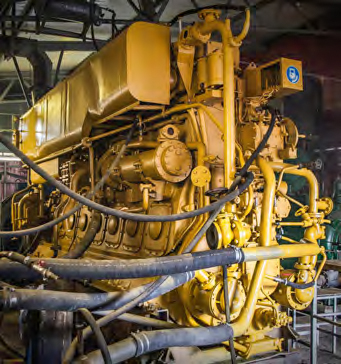Fuel consumption monitoring of river vessels.
DFM CAN flow meters with S6 Technology
Fuel consumption monitoring of river vessels.
DFM CAN flow meters with S6 Technology
![]() Customer: transport company*
Customer: transport company*
![]() Task: reduction of fuel consumption, preventing fuel misuse
Task: reduction of fuel consumption, preventing fuel misuse
![]() Machinery: dry-cargo ships – vessel engines, diesel generators, boilers
Machinery: dry-cargo ships – vessel engines, diesel generators, boilers
![]() Solution: DFM CAN flow meters with S6 Technology, GPS-trackers
Solution: DFM CAN flow meters with S6 Technology, GPS-trackers
![]() Result: fuel consumption is reduced by 50%
Result: fuel consumption is reduced by 50%
The Customer
The company has several directions of operation. One of them is transportation of goods by river. Company owns dry-cargo vessels, such as “Kriushi”, “Kozmodemiansk”, “Ochakov”. Vessels are operated in river basins, and also on lakes.
The Machinery
Vessels belong to “6th five-year plan, project 576” type: four cargo compartments and a superstructure on stern. Vessel’s length is 94 meters, carrying capacity – 2000 tons, fuel tanks volume – 50 tons, crew – 9 people.

Each vessel is equipped with: two engines, left (1) and right (2), main diesel generator (3), auxiliary diesel generator (4) and boiler (5).

The Task
Used fuel is accounted using calculation method – ship crew fills in trip statements taking in account approved fuel consumption quotas. Fuel quotas are approved in regulatory documents, which are several years out of date. Fleet owner considered those quotas were too high.
The task was to implement fuel monitoring system that would provide accurate information on instant and total fuel consumption of each engine in real time.
“Kriushi” dry-cargo vessel became the first to be equipped with the fuel monitoring system.
The Solution
Fuel monitoring system of diesel units includes 5x DFM fuel flow meters with CAN j1939/S6 interface and 1x Galileosky Glonass/GPS v.5.0. telematics unit. All equipment is operated over S6 Technology.
DFM 250CCAN flow meters are mounted into fuel lines of main engines. DFM 100CCAN are mounted into fuel lines of diesel generators and boiler.
The tracking device receives the following data from fuel flow meters via CAN/S6 interface:
- instant fuel consumption of every engine,
- total fuel consumption of every engine,
- operation time of every engine.
Also, tracking device receives additional data – fuel temperature and engine speed (from tachometer).
Information from the tracking device is sent to dispatch service’s computer, so they can see ship location and fuel consumption data in real time. All data is available on a virtual dashboard of ORF4 telematics service. Flexible dashboard interface allows to display data in any convenient form: charts, figures, arrow indicators, scales.

Hourly and total fuel consumption:
- Left engine.
- Right engine.
- Main diesel generator.
- Reserve diesel generator.
- Boiler.

Nikolai Turetskov,
Mercury NN (Technoton’s partner)
“Technoton manufactures a wide range of DFM fuel flow meters for all kinds of vehicles.
On “Kriushi” vessel we mounted DFM CCAN fuel flow meter and a tracking devise with CAN
input. All devices work within S6 Telematics interface. This is the most practical, simple and
reliable solution for fuel consumption monitoring of vessel with several diesel engines.”
The Result
After fuel monitoring system was installed, the customer started to receive reliable fuel consumption data in real time. Based on information about operation modes (engine speed, temperature) and fuel consumption of every engine, it became possible to define real average fuel consumption, prevent fuel consumption overstatement and cut total fuel costs.
Average total fuel consumption when vessel is moving is about 100 L per hour. This is two times lower than regulatory documentation states. Fuel economy per one machinery hour is 61.50 USD (in June 2017 prices).
Total costs for purchasing and mounting fuel monitoring system paid off twice during the first trip of the vessel.
Customer company
“We are completely satisfied with how Technoton products are working. Data about fuel consumption of every engine and generator is available in real time. We also like the format of getting reports – simple and clear virtual dashboard.
All costs for equipment and its installation paid off several times on the first trip!
We plan to install fuel consumption monitoring system on “Kozmodemianks” and “Ochakov” dry-cargo vessels and other vessels of our company.”
*Data is hidden from public access to comply with GDPR requirements. Details on the project can be disclosed upon signing NDA and with the consent of our partner.

